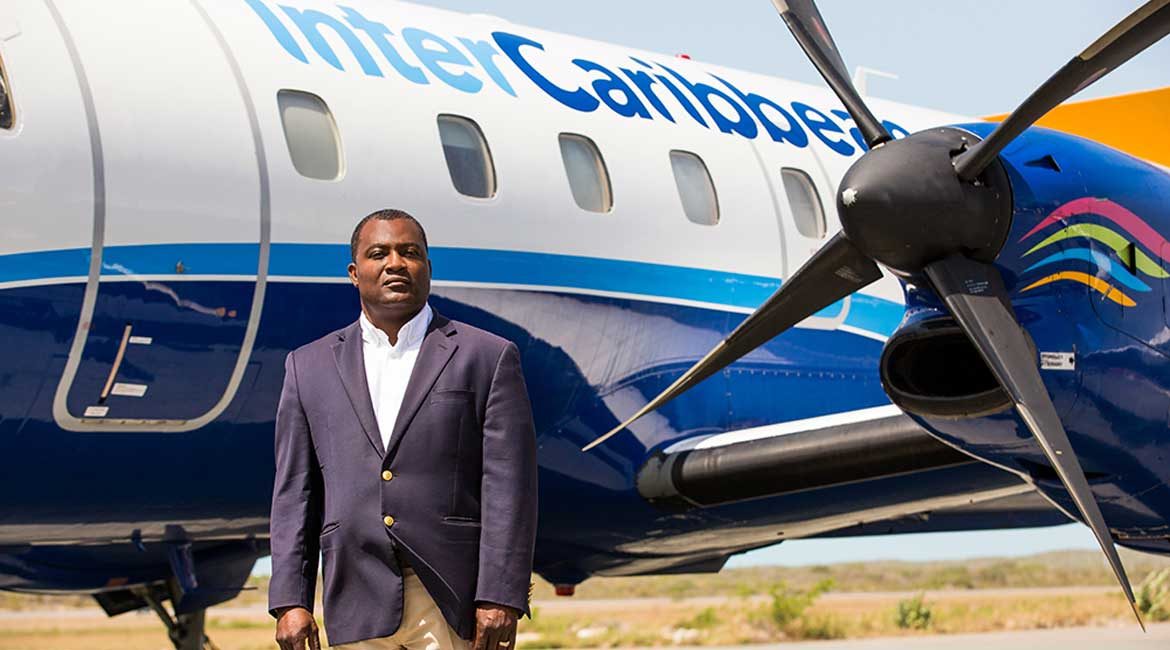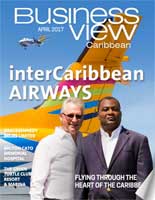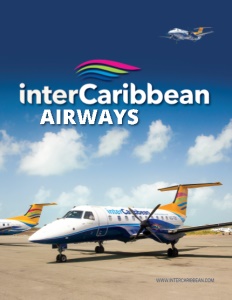Business View Caribbean interviews Lyndon Gardiner , founder of interCaribbean Airways , as part of Best practices in Turks and Caicos Islands Business.
“I started the company by having a love affair, not with the air – with a lady.” So begins the history of interCaribbean Airways Ltd., founded in 1991 by Lyndon Gardiner, who, by following his own heart, wound up owning and operating a wide-ranging group of air transport and air services companies in the Turks and Caicos Islands in the heart of the northern Caribbean.
“I was working at a bank and I had fallen in love with a lady from the Dominican Republic and I wanted to have the opportunity to go over there and see her,” Gardiner continues. “The scheduled flight left on Friday morning, so I would have to leave work to try and catch that flight. I took a couple of Fridays off and then my boss got upset with me, and complained that I was never there on a Friday, so he asked me if there was anything he could do for me. I told him if I had enough money, I would be able to go to Florida and get my pilot’s license and then I’d be able to fly, myself. He went ahead and gave me a loan – about $5,000 – and I went to Florida, and in three week’s time, I had my private pilot’s license.
“A couple of months later we were having the same conversation about me always being missing on a Friday. So I said to him, ‘Well, I don’t have an airplane.” And he said, ‘How much does that cost?’ It was about twenty-something thousand dollars, so I said, ‘I have six thousand and could he lend me the difference?’ I guess I was a good employee – he agreed to lend me the money. I bought my first airplane and I continued to work for the bank and do some flying.
“One Friday afternoon at the airport, where the residents and local people hang out, a friend who owned a photo studio said, ‘There’s a billfish tournament, tomorrow. Why don’t you take me out in the airplane? You can take the door off, fly low and slow. I’ll get some pictures and I’ll compensate you for the costs.’ So, I agreed and the next morning we flew about thirty or forty minutes and turned around and came back. He got the pictures he wanted and when we landed, he gave me five hundred bucks. It was the crispiest five hundred dollars I had ever seen. So, I called my manager and told him, ‘I quit.’ He was not very happy about that, and called in his loan. That meant I was completely on my own.
“Back in the day, I would hang out at the airport and operate a sort of taxi service. I was not properly licensed at the time; I was a private pilot. But, we’d all be out there on the hustle – getting passengers and taking them to the other islands, which were not very far from one another. On one of my trips back, I met the Deputy Director of Civil Aviation and, as I was coming off the airplane, he warned me about taking passengers for hire. Of course I told him that these people that I had were all friends and family and people that I knew forever. He questioned all three people I was flying in my Cessna 172, and no one agreed with him that I was getting paid. So, he told me, ‘Look, I’ll make a deal with you, because if anything happens to this airplane, you’re in trouble and we’re in trouble.’ I said, ‘I can understand why I’ll be in trouble, but why would you be in trouble?’ He said, ‘Because we’re from the CAA and we’re supposed to be protecting the public interest and it would not look that we were protecting the public interest if we just allow you to fly around without a proper air operator’s certificate.’ So, he said, ‘You come to my office and I’ll show you what you need to do. Once you comply with all the regulations, we’ll give you an AOC (Air Operator’s Certificate).’ In six months I had the AOC which allowed me to do on-demand charters.
“I had saved up enough money to buy a Piper Aztec and began flying charters. I incorporated a company and called it ‘Kerrmont Interisland Airways,’ and we started flying charters up and down the Caribbean. My brother came to work for me, and a friend on the island decided to help me out, part-time, and he eventually became the chief pilot, because my time on the ground became more important, trying to run and manage the business.
“So, the company grew. I did a lot of medevac flights and a lot of flights all over the place – bad weather, nights and, of course, those flights, you can pretty much name the number you want, because when someone’s got a medical emergency, they’ve got to go. The Turks and Caicos at the time had very limited medical facilities. A majority of the flights took people to Grand Turk, where they had the hospital but others were to regional capitals such as Port a Prince, Kingston and Santo Domingo. And we did a bunch of charters where people were coming to the islands and then wanting to do multi destination vacations, moving on to other places. So that’s where the roots of company were.”
By 2003, the Turks and Caicos government began a push toward regional and international development and it seemed the time had come for the country to have its own airline. Gardiner applied for, and was granted, a scheduled license and began an ambitious expansion project that involved adding international destinations and acquiring larger and faster aircraft. The company became Air Turks & Caicos in order to serve key international destinations, with daily scheduled flights to cities in Haiti, the Dominican Republic, Jamaica, the Bahamas, and Puerto Rico. “We rebranded the company to take advantage of all of the growth in the tourism sector. We had all these people coming, and working, and having businesses, and growing their empires in the Turks and Caicos. So our focus was to try and take advantage and become the premier way for them to get from one island to another.”
Gardiner also expanded his own empire to include five main operating companies. “All the companies in my group are one hundred percent owned by me. There is an FBO (Fixed-Based Operator) called Provo Air Center, and we’ve just been named the best Caribbean FBO for the second year in a row. We also have a ground handling company called Flight Support and, of the ten airlines flying into Turks and Caicos, we do the ground handling for nine of them – Delta, United, British Airways, Air Canada, WestJet, Jet Blue and others. Ground handling is passenger and baggage services. Once the airplane lands, we marshal all the passengers off; we take all the bags off and when people come to the airport, we do all the check-in, security scanning, etc. We’ve got a third company called Caribbean Aviation Maintenance Services. It’s a Turks and Caicos MRO – Maintenance Repair Organization. We provide on-call maintenance for those airlines as well as for our airline and the FBO when we have transient and visiting aircraft, business jets, etc. We also have another company called Professional Aviation Security Services; we deal with all the security aspects of protecting aircraft and passenger assets while they’re on the ground in the Turks and Caicos. We also have a fueling operation – Caribbean Aviation Fuel Services that provides fueling to, I’d say, the greatest percentage of all the aircraft traffic that comes into the Turks and Caicos. So, it’s a very encompassing aviation group.”
In 2008, Gardiner bought out his main competitor, doubling the size of his operations, overnight. “We were competing FBOs, competing ground handlers, competing airlines, competing maintenance organizations, competing fueling,” he explains. “At the time, the economy was very busy in terms of real estate development and the person who had owned the other company had gotten involved in a couple of projects, and so we made an offer and bought it.” With the acquisition, Gardiner now managed a larger percent of the islands’ air services business.
In 2013, the company went through yet another transition. “From 2009 to 2012, the economy went into sharp decline and then got to a standstill,” Gardiner says. “So, we had to change our strategy. It was no longer bringing people to and from the Turks and Caicos, because there weren’t many people left that wanted to come. We saw an opportunity of becoming the connecting force in the Caribbean and with that, we rebranded the company interCaribbean Airways. Shortly thereafter, Trevor Sadler came and joined us as the company CEO, with the sole focus of modernizing the airline and seating, the sales and marketing machinery in place that makes an airline tick. For instance, being able to buy tickets – right now, you can buy our tickets in 170 countries at thousands of locations, including all the online travel agencies. And that was certainly not an amenity we were able to offer our customers prior to a couple of years ago; it was all people who knew the company, or they had to go to a certain spot and we were the only ones going there. And that’s how most of our sales were gotten. Now, we’re operating in nine countries and 18 destinations, and we have a pretty good connectivity within the northern Caribbean.
“Also, in 2016, we expanded our FBO facility; we created a new, 10,000 square foot facility and we paved about 12 more acres of land for parking for the airplanes. We have the world’s only golf cart customs and immigration facility, to service elderly people or people who have mobility issues. They can get off the airplane and drive through the facility on a golf cart and go through the whole customs and immigration process at the other end. That’s a one-of-a-kind amenity. And, there are a lot of other amenities that we offer at the FBO.”
In fact, the new Provo Air Center is capable of hosting aircraft as large as a Boeing 777. It has expanded pilot facilities, multiple arrival and departure halls with enhanced flexibility, private conference rooms, dining space, a gift shop, a club lounge, a special children’s lounge, a coffee bar, a dedicated pet area, a well-equipped catering kitchen, an onsite laundry, and complimentary, upgraded Wi-Fi throughout the entire facility.
Over the next several years, Gardiner expects to grow interCaribbean Airways’ footprint throughout the region. “It is our view that through alliances and associations with other entities and airlines in the region, we can form a web that allows people to have more free movement throughout the Caribbean,” he states. “Part of our strategy involves putting down more assets. We’re looking at operating some smaller jets and perhaps operating some larger aircraft and enhancing the product that we have. We see the Caribbean market as growing, and as it begins to market itself as a single destination, we feel that there’s a future in providing airlift between the various countries in the Caribbean.
“Primarily now, the two ways to get around the Caribbean is to either fly via Miami or Ft. Lauderdale, or through Panama, and those are very circuitous routes. If I take, for instance, a flight from Santa Domingo to Kingston, Jamaica – if someone flew with us, we offer that service within three hours, stopping through the Providenciales hub that we created. The other alternative is six hours via Copa through Panama, or up to eight or nine hours via one of the U.S. carriers. So, we’re adding a lot of value by giving people a lot of time back; you don’t have to fly the circuitous route. You’re able to have a dollar savings moving from point A to point B. And as the weeks, months, and years go by, we’re certainly seeing where our services are becoming more in demand – we’ve got the airplanes, we’ve got the IT structure in terms of reservations, flight management, and sales.
Lyndon Gardiner doesn’t fly much anymore, but he hasn’t given up on returning to the skies. “I’m celebrating my 50th birthday later this month, so I’m hoping to get back to being able to get behind the stick, again. I certainly enjoyed it, but I’ve got 8500 hours worth of commercial flying, so I don’t particularly need to be up there. But I would like to still go and enjoy myself, because that’s where it all started from, and I’d like to be able, in my later years, to enjoy that before I’m too old to do it.”
And by the way – that gal in the Dominican Republic that Gardiner just had to visit on Fridays? She became his wife.
All’s well that ends well in affairs of the heart.
AT A GLANCE
WHO:interCaribbean Airways
WHAT: A regional airline and group of air services companies
WHERE: Providenciales, Turks and Caicos Islands
WEBSITE: www.intercaribbean.com




 This information will never be shared to third parties
This information will never be shared to third parties